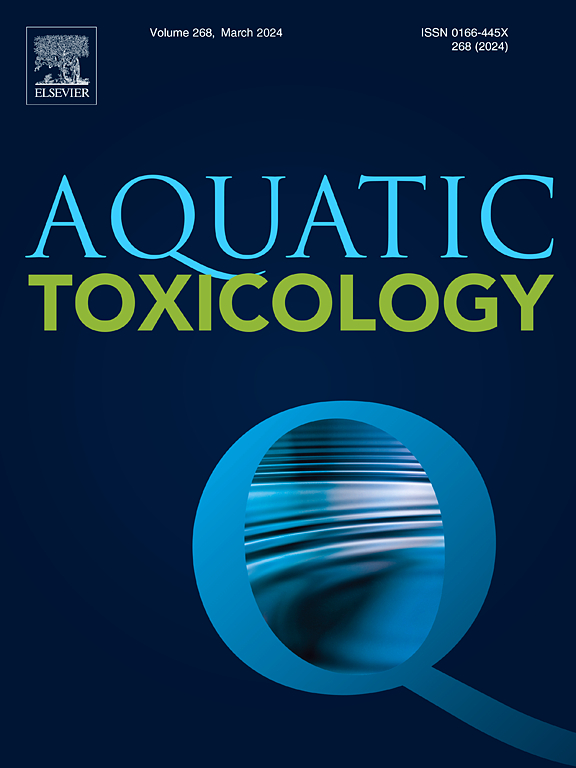Unraveling the immunotoxic effects of benzo[a]pyrene on Mytilus coruscus through histopathological, enzymatic, and transcriptomic analyses
IF 4.1
2区 环境科学与生态学
Q1 MARINE & FRESHWATER BIOLOGY
引用次数: 0
Abstract
Benzo[a]pyrene (BaP) is a representative polycyclic aromatic hydrocarbon (PAH) known for its significant toxicity and environmental persistence, capable of causing mutations, deformities, and cancer in aquatic organisms. However, systematic studies on the effects of BaP exposure on histological damage, cell apoptosis, enzyme activity changes, and gene expression in Mytilus coruscus (M. coruscus), an important ecological indicator species, remain scarce. In this study, the biological effects of BaP on M. coruscus and the immunotoxic mechanisms following BaP exposure were evaluated using histological analysis, TUNEL assay, enzyme activity assays, and transcriptome sequencing. Our findings revealed notable histopathological changes due to BaP exposure, including hemocyte infiltration, atrophy, and deformation of digestive tubules in the digestive glands, as well as epithelial cell detachment and deformation in gills. Antioxidant enzyme activities (CAT, GSH-Px, SOD, T-AOC) varied significantly across tissues under BaP stress. Additionally, significant DNA fragmentation and increased apoptosis were observed in BaP-exposed groups compared to controls. Transcriptome analysis showed that after BaP exposure, nucleotide excision repair and innate immune response pathways were suppressed, while the metabolism of xenobiotics by cytochrome P450, glutathione biosynthesis, and apoptosis pathways were upregulated. These results elucidate the toxic mechanisms of BaP on M. coruscus and the immunotoxic responses of the mussels. This study enhances our understanding of how BaP and similar pollutants affect marine bivalves, providing valuable insights for environmental monitoring and pollutant management strategies.
通过组织病理学、酶和转录组学分析揭示苯并[a]芘对贻贝的免疫毒性作用
苯并[a]芘(BaP)是一种典型的多环芳烃(PAH),以其显著的毒性和环境持久性而闻名,能够引起水生生物的突变、畸形和癌症。然而,关于BaP暴露对贻贝(Mytilus coruscus, M. coruscus)这一重要生态指示物种的组织损伤、细胞凋亡、酶活性变化和基因表达的影响,目前还缺乏系统的研究。本研究采用组织学分析、TUNEL测定、酶活性测定和转录组测序等方法,评估了BaP对褐皮霉的生物学效应以及BaP暴露后的免疫毒性机制。我们的研究结果显示,BaP暴露导致了显著的组织病理学变化,包括消化腺中消化小管的血细胞浸润、萎缩和变形,以及鳃中上皮细胞脱离和变形。抗氧化酶活性(CAT、GSH-Px、SOD、T-AOC)在BaP胁迫下各组织间差异显著。此外,与对照组相比,bap暴露组观察到显著的DNA断裂和细胞凋亡增加。转录组分析显示,暴露于BaP后,核苷酸切除修复和先天免疫应答通路受到抑制,而细胞色素P450、谷胱甘肽生物合成和凋亡等外源代谢通路上调。这些结果阐明了BaP对贻贝的毒性机制和免疫毒性反应。本研究增强了我们对BaP和类似污染物如何影响海洋双壳类动物的理解,为环境监测和污染物管理策略提供了有价值的见解。
本文章由计算机程序翻译,如有差异,请以英文原文为准。
求助全文
约1分钟内获得全文
求助全文
来源期刊

Aquatic Toxicology
环境科学-毒理学
CiteScore
7.10
自引率
4.40%
发文量
250
审稿时长
56 days
期刊介绍:
Aquatic Toxicology publishes significant contributions that increase the understanding of the impact of harmful substances (including natural and synthetic chemicals) on aquatic organisms and ecosystems.
Aquatic Toxicology considers both laboratory and field studies with a focus on marine/ freshwater environments. We strive to attract high quality original scientific papers, critical reviews and expert opinion papers in the following areas: Effects of harmful substances on molecular, cellular, sub-organismal, organismal, population, community, and ecosystem level; Toxic Mechanisms; Genetic disturbances, transgenerational effects, behavioral and adaptive responses; Impacts of harmful substances on structure, function of and services provided by aquatic ecosystems; Mixture toxicity assessment; Statistical approaches to predict exposure to and hazards of contaminants
The journal also considers manuscripts in other areas, such as the development of innovative concepts, approaches, and methodologies, which promote the wider application of toxicological datasets to the protection of aquatic environments and inform ecological risk assessments and decision making by relevant authorities.
 求助内容:
求助内容: 应助结果提醒方式:
应助结果提醒方式:


